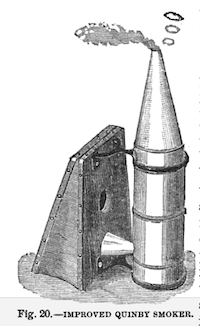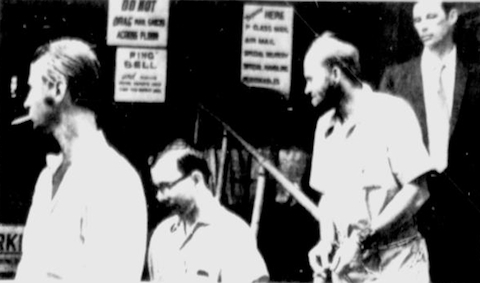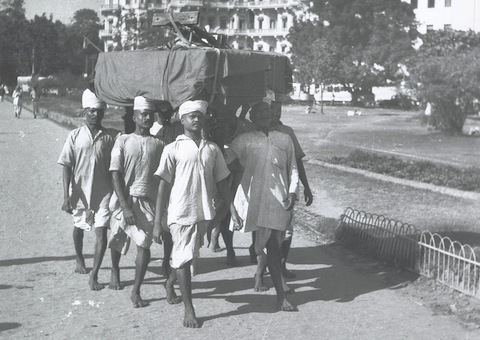Brendan I. Koerner's Blog, page 50
February 15, 2011
The Quinby Smoker
 Behind every mass-market product is an invention that made its creation cost-effective. In the case of honey, that technological marvel is the humble bellows smoker, which produces a non-toxic haze with the power to chill out agitated bees. It does so by messing with a colony's communications system: Sentries are supposed to alert warriors to the approach of a threat (such as a beekeeper), a task they're designed to accomplish by releasing powerful pheromones. But the smoke interferes with the sentries ability to secrete those key chemicals, and so the highly venomous soldiers ever get the signal to attack.
Behind every mass-market product is an invention that made its creation cost-effective. In the case of honey, that technological marvel is the humble bellows smoker, which produces a non-toxic haze with the power to chill out agitated bees. It does so by messing with a colony's communications system: Sentries are supposed to alert warriors to the approach of a threat (such as a beekeeper), a task they're designed to accomplish by releasing powerful pheromones. But the smoke interferes with the sentries ability to secrete those key chemicals, and so the highly venomous soldiers ever get the signal to attack.
For centuries, the problem for beekeepers was how to produce a steady, long-lasting stream of smoke that would directly target the hive. Finally, in 1870, the great Moses Quinby devised an efficient bellows smoker that made modern beekeeping possible. A 1947 encyclopedia of the profession's arcana paid tribute to Quinby's genius:
One can drive cattle and horses, and to some extent even pigs, with a whip, but one who tries to control bees without smoke will find to his sorrow that the rest of the animal kingdom are mild in comparison, especially so far as stubbornness and reckless fearlessness of consequences are concerned. One may kill them by the thousands or may even burn them up with fire; but the death agonies of their comrades seem only to provoke them to a new fury, and they rush to the combat with a relentlessness which can be compared to nothing better than a nest of yellow jackets that have made up their minds to die, and to make all the mischief they possibly can before dying. It is here that the power of smoke comes in; and to one who is not conversant with its use it seems simply astonishing to see bees turn about and retreat in the most perfect dismay and fright, from the effects of a puff or two of smoke from a mere fragment of rotten wood. What could beekeepers do with bees at times, were no such potent power as smoke known?
Much more on the history of bee smokers here, including a rundown of who benefited from the fact that Quinby neglected to patent his landmark invention.
February 14, 2011
Avoiding the Dreaded Shoelace Belt
This is gonna be a rough week, as we're solely in charge of Microkhan Jr. while the Grand Empress is off doing her thing in Vega$. The good news is that, with the aid of several Yuenglings last night, I believe that I've been able to reset my internal clock to deal with the situation at hand. But time will be extra-precious these next few days, so expect more factoid-y posts than usual. And today I can only give you two small Valentine's Day gifts: the finest Nas verse ever (NSFW, of course), and a link to one of my favorite modern love poems. The kickout on the latter is incredible:
Love does not last, but it is different
from the passions that do not last.
Love lasts by not lasting.
Isaiah said each man walks in his own fire
for his sins. Love allows us to walk
in the sweet music of our particular heart.
Even more highly recommended from Jack Gilbert's body of work (though a fair bit darker): "Tear It Down"
Enjoy, and see you back here tomorrow for a bit of Taiwanese crime history. Or maybe Romanian viper farming. All depends on my success in getting Microkhan Jr. to preschool on time.
February 11, 2011
The Greenless Island

Abandoned human settlements are a pet topic 'round these parts, so I couldn't resist the urge to post about the Japanese island of Hashima (aka Gunkanjima). Entranced by this haunting collection of photos, I tracked down a primer on the coal-mining outpost's tragic history. As is so often the case with operations designed to pillage the Earth in the quickest, most cost-efficient manner possible, the men who did the dirty work suffered greatly—especially during World War II, when Korean slave labor was employed. The situation got markedly better in the post-war period, but Hashima still sounds like it was a rather glum place to make one's living:
The population of Hashima reached a peak of 5,259 in 1959. People were literally jammed into every nook and corner of the apartment blocks. The rocky slopes holding most of these buildings comprised about 60 percent of the total island area of 6.3 hectares (15.6 acres), while the flat property reclaimed from the sea was used mostly for industrial facilities and made up the remaining 40 percent. At 835 people per hectare for the whole island, or an incredible 1,391 per hectare for the residential district, it is said to be the highest population density ever recorded in the world. Even Warabi, a Tokyo bedtown and the most densely populated city in modern Japan, notches up only 141 people per hectare…
The community depended completely on the outside world for food, clothing and other staples. Even fresh water had to be carried to the island until pipes along the sea floor connected it to mainland reservoirs in 1957. Any storm that prevented the passage of ships for more than a day spelled fear and austerity for Hashima.
The most notable feature of the island was the complete absence of soil and indigenous vegetation. Hashima, after all, was nothing more than a rim of coal slag packed around the circumference of a bare rock. A movie shot there by Shochiku Co. Ltd. in 1949 was aptly entitled Midori Naki Shima (The Greenless Island).
Mine-owner Mitsubishi eventually made a calculated business decision to abandon Hashima, thereby creating one of the eeriest ghost towns this side of Kadykchan. It now resembles something straight out of one of my childhood touchstones: the hollowed-out cities of the third Robotech series, set in a not-too-distant future in which an alien race has conquered the planet. The only thing missing on Hashima are the heaped-up carcasses of soldiers and Cyclones. (Yeah, Robotech was dark like that.)
More on Hashima via this 2002 documentary.
February 10, 2011
Caught in the Grip
Deadline day here at Microkhan headquarters, so please make do with some downbeat Canadian dream pop for now. Listen closely for a moment that obviously made a big impact on Dan the Automator, seeing as how he copped it for a Deltron 3030 chorus.
February 9, 2011
…But Somebody's Gotta Do It
 A dozen years ago, this New York Times Magazine story wormed its way into my memory banks by citing a single, jaw-dropping stat: "About 70 percent of all Indian motel owners—or a third of all motel owners in America:mdash;are called Patel, a surname that indicates they are members of a Gujarati Hindu subcaste." After reading that tidbit on page one, how could I resist the urge to plow through the remaining 5,000 words?
A dozen years ago, this New York Times Magazine story wormed its way into my memory banks by citing a single, jaw-dropping stat: "About 70 percent of all Indian motel owners—or a third of all motel owners in America:mdash;are called Patel, a surname that indicates they are members of a Gujarati Hindu subcaste." After reading that tidbit on page one, how could I resist the urge to plow through the remaining 5,000 words?
The main takeaway from the piece wasn't just that Indians have come to dominate America's mid-market hospitality industry, but that certain immigrant groups have long made their way on these shores by specializing in particular industries. As the story's author explained:
America's motels constitute what could be called a nonlinear ethnic niche: a certain ethnic group becomes entrenched in a clearly identifiable economic sector, working at jobs for which it has no evident cultural, geographical or even racial affinity.
I don't mean Italians owning pizzerias, or Japanese people running judo schools. I mean, to use an obvious example, the Korean dominance of the deli-and-grocery sector in New York — a city where the Chinese run most laundries and Sri Lankans, in case you didn't know this, run most porn-video stores. Or the Arabs in greater Detroit, who have a stranglehold on gas stations, or the Vietnamese who monopolize nail salons in Los Angeles. Farther afield, I could mention London's taxi drivers, sharp-tongued in their big black cars, many of whom are Jews from the city's East End; or the security guards outside New Delhi's more affluent residences, virtually all of whom are Nepalese; or the prostitutes in the United Arab Emirates, who are so often women from Russia.
There is, of course, usually a prosaic reason why a group got involved in its preferred line of work. A perfect example of this is the way in which Japanese-Americans came to control the chick-sexing profession in the 1940s and '50s.
This tale of economic triumph has a single hero: S. John Nitta, who founded the American Chick Sexing Association in 1938. During the war, when over 100,000 of his fellow Japanese-Americans were interned, Nitta continued to train and certify sexors; once the conflict ended, former internees turned to chick sexing as one of their few routes to economic advancement. Nitta was compelled to open up new training facilities, leaving behind his initial schools to be run by fellow Japanese-Americans. By the dawn of the Eisenhower Era, well over 90 percent of America's chick sexers were of Japanese origin.
But Japanese-Americans lost this "nonlinear ethnic niche" quite quickly—partly because the next generation moved into more remunerative professions, but also because the advent of feather sexing opened up the enterprise to less skilled workers. But Nitta's association is still with us, though it's now down to two employees. I wonder if they still hand out these nifty certificates.
February 8, 2011
Devil in the Details

I'm juggling a pair of true-crime yarns at present, and thus taking a keen interest in the contortions of an ambitious robber's mind. What I'm starting to surmise is that even the sharpest crooks often lack a key mental skill: the ability to plan an endgame. Though their schemes may be brilliant on paper, criminals seldom put much thought into the details that truly matter. In other words, Dalton Russells are rare in the non-celluloid realm.
There is perhaps no greater illustration of this fact than the curious case of Eastern Air Lines Flight 393. In June of 1972, this Greensboro-to-Atlanta flight happened to be carrying $3 million worth of untraceable securities. A quintet of men somehow got hip to this fact, and plotted what seemed to be the perfect crime:
When Eastern Air Lines Flight 393 took off from Greensboro, N.C. at 9 p.m. Tuesday night it carried in its cargo hold $3 million in securities and a box containing a 39-year-old man. The latter, say the FBI, planned to steal the former…
Grant Clyde Cralley had been shipped prepaid in a cardboard and wood box about three-feet square, FBI agents said. The box had a removable door and was equipped with oxygen in case he needed it.
Alas, as it would later emerge during legal proceedings, the conspirators didn't realize that cargo is stacked in the belly of planes, with the biggest items on the bottom. And so the door to Cralley's crate was held shut by heavy mail sacks, and he was never able to emerge from his hiding place during the short flight.
The question then is why criminal minds typically make such basic miscalculations, even when their larger schemes exhibit a flair for intelligence. Dishonesty may be a thief's primary shortcoming, but carelessness ranks a close second. I reckon a civil society should be grateful for that fact.
February 7, 2011
The Opulent Goodbye
The late Hmong military leader Vang Pao is currently being memorialized in grand fashion, as his culture's traditions dictate:
[Vang Pao's] funeral — six days and nights, with 10 cows slaughtered and stir-fried each day — has become a send-off for the ages. It began last Friday, his body borne on a horse-drawn carriage through the streets of downtown Fresno, throngs of grieving Hmong lining the way. Scottish bagpipers played "The Green Hills of Tyrol" and two T-28 planes, the aircraft piloted by Hmong guerrilla fighters in the Vietnam War, flew overhead.
And the funeral rolled down a long red carpet through the weekend, as thousands more Hmong from across the country, and some from as far away as Thailand and France, strode into the convention center of this farming capital of California to say goodbye.
Such lavish funerals obviously serve a purpose beyond just allowing a man's admirers to grieve. They are created as evidence that a marginalized community is strong enough to survive its leader's passing. This has always been the subtext in those outrageously opulent Mafia funerals; they're not just about showing how much wealth and power a crook had accumulated, but also an attempt to demonstrate that his criminal realm will continue on in his absence. If a capo's underlings or successors can effectively gather the funds necessary to pay for this many flowers—not to mention work out the logistics of the procession and the afterparty—then surely they can comandeer the late man's rackets.
The trouble is, those who lack power still retain the competitive instinct, and so desire lavish funerals that have no political motive. This can be ruinous not just to a family, but to a society; in Ghana, for example, hands are frequently wrung over the percentage of income that is spent on ornate coffins. And for well over a century now, people in the U.S. have rightly feared that too much familial wealth is dedicated to big send-offs, rather than guaranteeing the security of the ensuing generations. The New York Times chimed in on the topic 125 years ago:
It would be surprising to learn how common it is for families in this and other large cities to overtax themselves to provide paraphernalia for the tomb. Not infrequently they spend every dollar that has been left, even exceeding the amount sometimes, and in many instances anticipating a large share, if not all, the insurance upon the life of the deceased. Not a few instances might be cited in which money has been borrowed to defray funeral expenses when, if the funeral and been modestly and properly managed, there would have been no need of borrowing at all. What an unworthy return is this to the man who has probably worked hard for years, and given himself less anxiety to save something for his family in the event of his sudden death! Of what advantage is it to him, in his sheeted sleep, that there should be a few more flowers or carriages, that the coffin should be real rosewood, or the handles genuine silver? All has ended; all is well with him. To him money is no longer essential; whatever he has gained beyond necessary expenditure, should be devoted to the service of the living.
This is why, when our time comes, this particular khan would like to be cremated and have the ashes strew somewhere meaningful—the acropolis at Marcus Garvey Park, perhaps, or the the subway platform where the Grand Empress entered the picture. However, it would also be nice if I could leave behind just enough money to fund a marble Microkhan Memorial Bench—to be manned by two 24-hour security guards armed with cattle prods, who will strictly enforce a "no sitting" policy. Is that too much to ask?
(Image via the )
February 4, 2011
"Champ of the Ivories"

I have done my earnest best to keep self-promotion to a minimum on Microkhan, while also refusing ads in order to preserve the pristine reading experience you've (hopefully) come to know and love. But, alas, I'm going to ask you to endure a bit of jersey-popping on this cold winter morn, as I try once more to convince y'all to invest a few moments and dollars in my latest major project: "Piano Demon," the debut story for new digital-only publisher The Atavist.
I first stumbled across Teddy Weatherford's name while researching Now the Hell Will Start; I rather randomly spotted his obituary while trolling through a reel of old Chicago Defender microfilm. Ever since, I've been more than a bit obsessed with the arc of this great pianist's life; a onetime child coal miner in Pocahontas, Virginia, he eventually became the most celebrated jazzman in Asia. A fixture of the elegant hotels and clubs where the colonial elite gathered to wallow in decadence while the continent descended into war, Weatherford provided the soundtrack for the last gasp of empire.
"Piano Demon" is exactly the sort of yarn that I'd love to make my professional bread-and-butter: a deeply reported nonfiction epic that blurs the line between truth and art. More important, I'm thrilled to have had the opportunity to shape the look and feel of the finished product with such an excellet, creative crew. I feel like "Piano Demon" is part of something embryonic but important—a reinvention of storytelling for the Tablet Era.
If you dig Microkhan or any of my other work, I beseech you to give "Piano Demon" a whirl—not only because I'm so proud of the project, but also because I get a fair cut of every purchase. It's a cheap way to show your support for your humble narrator, plus you'll learn more than you thought possible about coal-mining accidents, anti-jazz activism, the Shanghai underworld, and Bombay liquor laws, to name just a few of the topics covered.
If you can swing the technology, the iPad/iPhone version is highly recommended; the extra dollar buys you music, extra images, and a bevy of interactive features. But no worries if you're currently un-Appled; the Kindle version is a winner, too, and it can be read on a litany of devices (including PCs and Macs) by downloading one of Amazon's free apps. (Also, if you purchase the Kindle version, you can continue to help "Piano Demon" outrank the Mötley Crüe biography.)
And there endeth the self-promotion. Back to your regularly scheduled programming next week: kidnapping rumors, the pig economy in Papua New Guinea, and the gaudy splendor of Mafia funerals.
(Image of Calcuttans transporting a piano via the Digital South Asia Library)
February 3, 2011
The Fanged King
The granddaddy of Malaysian vampire flicks, 1968′s Raja Bersiong tells the tale of a pre-Islamic king who develops a taste for human blood—a culinary affection that eventually leads him to grow long fangs, and then (spoiler alert!) to be killed by his subjects for paying more attention to his snacks than his royal duties. As related here, the movie was sort of the Heaven's Gate of late 1960s Malaysian cinema:
As has often happened when a film industry is at a moment of crisis, Malay Film Productions (MFP) tried to spend its way out of trouble by making an expensive color and widescreen epic that could turn the tide. Raja Bersiong cost RM750,000, which was more than ten times the cost of the average film. The film was directed by Jamil Sulong and employed a Japanese crew, causing major production and communication problems. Even though the story was written by Malaysia's first Prime Minister, Tunku Abdul Rahman, and was a nationalist epic set in northern Malaysia, the film failed at the box office.
Hmmmm…any chance it was unwise to hire a politician to write a horror flick? I certainly wouldn't have wanted Margaret Thatcher doing the screenplay for 28 Days Later.
Check out the rest of the movie here; part three is highly recommended.
February 2, 2011
The Golden Age of Twice-Cooked Pork

Apologies to my vegetarian readers for what is about to commence: a post about the grisly business of producing pig meat, a delicacy that I seek out far more often than my arteries would like. (I will perform nearly any feat of self-abasement in exchange for some top-notch lechón.)
Though I'm accustomed to reading about expensive cuts of pork, I know little about the industrial system that gives America its much-beloved riblets. And so I was instantly grabbed by a snippet of news making the ag-industry rounds: the Hypor Maxter has arrived:
Hypor is pleased to announce the addition of the Hypor Maxter to its North American terminal boar portfolio. Exceptionally lean, efficient and fast growing, this Piétrain line sits next to Hypor's Kanto and Magnus Duroc terminal lines (including the DGI and Shade Oak populations). The addition provides producers in Canada and the United States with a comprehensive selection of terminal lines designed to optimise on-farm efficiency while meeting the diverse needs of the North American pork industry.
Originally developed by France Hybrides in 1971, the line was acquired by Hypor in 2008. The Hypor Maxter has achieved widespread commercial success in Europe where it is recognised for being the fastest growing Piétrain in the world. Recent Canadian commercial trials using imported semen have validated European results and demonstrate significant opportunity for the genes in the North American pork value chain. With ever increasing pressure on cost of production, the time was right to introduce the Hypor Maxter line to North America.
Hypor Maxter great grandparent males and females were imported to Manitoba, Canada in July 2010 from Hypor's Sichamps nucleus in France. Once Hypor and federal inspection processes were complete, the Hypor Maxters were moved from the isolation facility to the Lockport, Manitoba nucleus facility in November 2010. Maxter boars are also being placed in Hypor's Greenhill Gene Transfer Center and semen will be available for phase two commercial evaluation with strategic partners across Canada and the United States in early 2011.
There's a lot to chew over here, such as the ethically dicey proposition that a mammalian genetic profile can be transferred between companies like surplus desks. But I'd like to focus on the upshot of the Hypor Maxter's North American rollout: continued access to dirt-cheap pork, for better and for worse. The Maxter's chief selling point is its growth potential—that is, it gets mighty huge in a relative hurry, thereby keeping producer costs in check. But the meat quality seems to be in question, as evidenced by this 2003 study comparing Pietrains to Durocs:
Subjective meat quality scores for color, marbling, and firmness (1 to 5 scale) were more favorable for Duroc-sired progeny. Furthermore, chops from Duroc progeny had higher 24-h pH (5.53 vs. 5.48, P < 0.001) and Minolta a* (17.33 vs. 17.04, P < 0.05) with less percentage drip loss (2.88 vs. 3.80, P < 0.001). No differences were detected between Duroc- and Pietrain-sired progeny for Minolta L* (54.77 vs. 55.37) or b* (7.58 vs. 7.58) objective color scores, percentage cooking loss (28.63 vs. 29.23), or Warner-Bratzler shear force (6.94 vs. 7.11 kg).
So expect your pan-fried dumplings to remain vanishingly cheap in the coming years, thanks to the blessings of science. But speaking for myself alone, I won't be able to tuck into cheap pork with quite the same abandon knowing that I'm feasting upon a slice of Hypor's "terminal boar portfolio."




